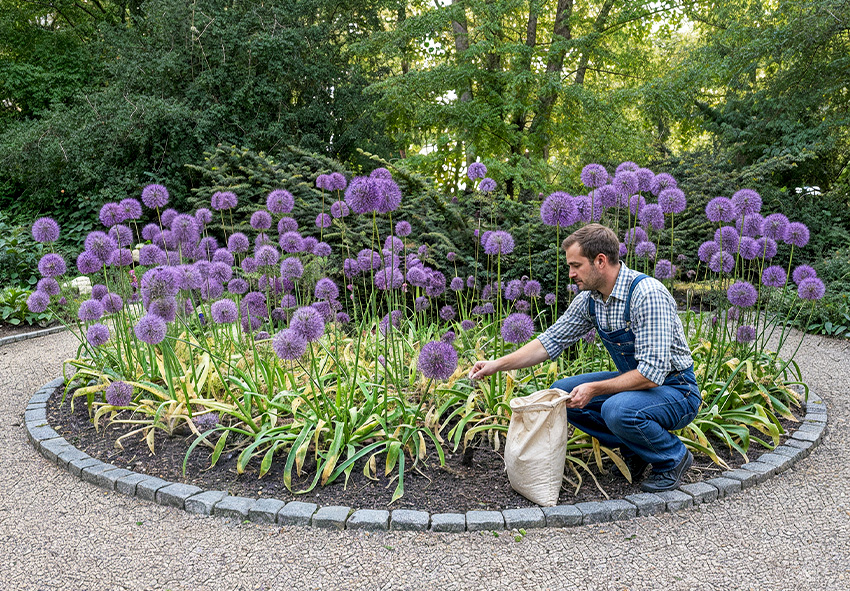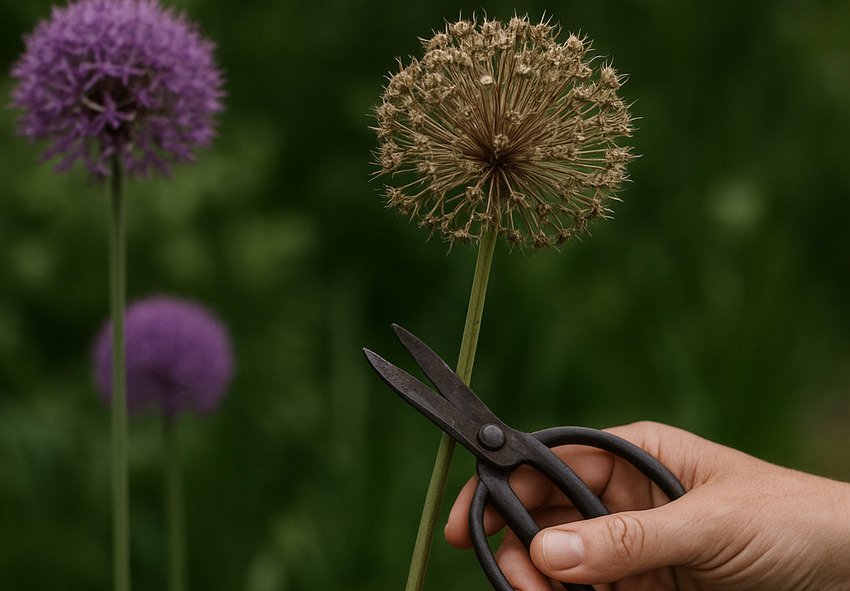Alliums are among the most elegant and eye-catching garden bulbs, admired for their tall stems and globe-shaped clusters of vibrant blooms. While they’re often praised for being low-maintenance, proper seasonal care ensures they return stronger and more beautiful each year. Knowing how to grow alliums and care for them in every season helps you keep your flower beds healthy, colorful, and thriving.
In this guide, you’ll find practical allium care tips for spring, summer, autumn, and winter — so your garden stays stunning all year round. Our gardening blog is a perfect place to find all the information you need!
Spring Allium Care: Encouraging Strong Growth

Spring is the season when alliums awaken from dormancy and begin their active growth phase. This is the most critical time to nurture shoots, encourage strong stems, and prepare for vibrant blooms. A few simple actions now can set your plants up for a successful flowering season.
Support Early Shoots
When the first green shoots appear, gently remove any winter mulch and loosen compacted soil around the base. Keep the area clear of weeds to reduce competition for nutrients and water. This small effort helps new growth establish faster and healthier.
Watering and Feeding
Proper watering and feeding are key to keeping your alliums strong, vibrant, and full of energy for future blooms. These easy allium care tips ensure the bulbs get the right balance of moisture and nutrients throughout the growing season — without overwatering or stressing the plants. Consistency is more important than quantity, especially when the bulbs are forming and storing energy. Here are some tips for you:
- Maintain Moderate Moisture: Alliums dislike soggy soil. Water them only when the top layer of soil feels dry, ensuring it drains well. Overwatering can cause bulb rot, while too little water may lead to stunted growth and weak stems.
- Adjust Watering by Season: Increase watering during spring and early summer when growth is active, then reduce it as foliage starts to yellow in late summer. During winter dormancy, keep the soil barely moist to prevent drying out.
- Feed in Early Spring: When new shoots appear, apply a slow-release, potassium-rich fertilizer to encourage strong stems and large flower heads. Avoid high-nitrogen fertilizers, which produce excessive foliage at the expense of blooms.
- Replenish Nutrients After Blooming: After flowering, add compost or a mild bulb feed to restore nutrients used during blooming. This step supports allium bulbs care and helps them store energy for next year’s growth.
- Improve Soil Naturally: Incorporate organic matter like compost or well-rotted manure into the soil each year. This boosts drainage, aeration, and nutrient levels — creating the ideal growing conditions for healthy alliums.
Sunlight and Spacing
Alliums thrive in full sun, ideally receiving six or more hours of direct light daily. Space them properly to ensure good airflow, which prevents fungal diseases and keeps foliage fresh throughout the season. Healthy spacing also gives each plant room to display its beautiful blooms.
Summer Allium Care: Prolonging the Bloom
Summer is when your alliums take center stage. Their stunning globes fill the garden with texture and color, and with the right care you can not only prevent alliums pests and diseases, but also extend their display while keeping the bulbs strong for next year.
Maintain Moisture Levels
During warm summer days, ensure consistent watering but allow the top layer of soil to dry out between sessions. Overwatering can cause bulb rot, especially in heavier soils. For allium flower maintenance, aim to keep the soil slightly moist but never soggy.
Deadhead Spent Flowers

Once blooms begin to fade, cut back the flower heads to prevent seed production. This directs the plant’s energy back into the bulb, ensuring strong growth next spring. Leave the foliage intact until it naturally yellows — it’s still working to store nutrients.
Support Tall Varieties
Large ornamental alliums like Allium giganteum or Allium schubertii may need staking to withstand wind or heavy rain. Use soft garden ties to secure the stems gently, maintaining their elegant upright form without damaging the plant.
Autumn Allium Care: Rest and Recovery
As autumn arrives, alliums shift from active growth to energy storage. While the garden slows down, this season is vital for helping bulbs recover and prepare for dormancy. With a little attention now, you’ll ensure next year’s blooms remain healthy and vigorous:
- Foliage Management: Allow the foliage to die back naturally before trimming it away. Cutting the leaves too early can prevent bulbs from storing enough nutrients for the following year. Once the leaves are fully dry and yellow, remove them carefully to keep the area tidy.
- Soil Refresh and Feeding: Give your bulbs a nutrient boost before winter by adding a layer of compost or bulb-specific fertilizer. Lightly loosen the soil around them to improve aeration and support root health. This allium bulbs care step helps bulbs regenerate and prepare for the next blooming cycle.
- Moisture Control: As temperatures cool, reduce watering gradually. While you don’t want the soil to dry out completely, excess moisture can cause rot. Focus on keeping the soil slightly damp and well-drained as the plants enter dormancy.
Winter Allium Care: Protecting Dormant Bulbs
Winter is a resting period for alliums, but that doesn’t mean they can be ignored. Proper seasonal allium care during the colder months ensures bulbs stay safe from frost damage and are ready to burst back to life in spring.
Check Container Alliums
Container-grown alliums bring beauty to patios, balconies, and small gardens — but they need a little extra attention compared to those planted in the ground. Pots expose bulbs to greater temperature changes and moisture fluctuations. With the right allium care tips, you can keep your container alliums healthy, well-protected, and ready to bloom year after year:
- Move Containers to Sheltered Spots: When cold weather sets in, relocate pots to a protected area such as a greenhouse, porch, or near a house wall. This helps buffer the bulbs from freezing winds and harsh frost while still allowing them to rest naturally during winter.
- Insulate for Winter Protection: Wrap pots in burlap, bubble wrap, or garden fleece to retain warmth. Insulation prevents sudden temperature drops that can damage bulbs or crack ceramic containers. Even a layer of mulch on the surface can make a big difference.
- Monitor Soil Moisture: Check the soil occasionally during dormancy — it should stay slightly moist but never waterlogged. Overwatering in winter is one of the most common causes of bulb rot in containers. Ensure pots have good drainage holes to keep the bulbs healthy.
- Refresh Soil Annually: Before the next growing season, remove the top layer of old soil and replace it with fresh compost or bulb mix. This restores nutrients and improves drainage, an essential part of allium bulbs care for potted plants.
- Replant or Divide When Crowded: Every two to three years, check if bulbs are overcrowded. Lift, divide, and replant them into fresh soil to encourage better airflow and stronger blooms. Healthy spacing keeps your container alliums thriving and visually appealing.
Mulching for Insulation

Add a layer of organic mulch, such as straw or compost, to protect bulbs from freezing temperatures. This insulation keeps the soil temperature stable and helps retain just the right amount of moisture.
Avoid Overwatering
Dormant bulbs need very little water. In fact, too much moisture can cause them to rot during winter. If you live in a region with frequent rain, make sure the soil drains well or consider planting bulbs in raised beds.
Conclusion
With consistent, thoughtful care through each season, your alliums will reward you with years of vibrant, globe-like blooms and lush foliage. From early spring shoots to winter dormancy, every phase plays a part in keeping your bulbs healthy. Follow these allium care tips to enjoy resilient, beautiful plants that bring structure, color, and elegance to your garden every year!
Frequently Asked Questions (FAQs) about Care for Alliums
1. How often should I water alliums during the growing season?
Alliums prefer moderate watering. During spring and early summer, water them when the top few centimeters of soil feel dry, ensuring good drainage to avoid bulb rot. Reduce watering as the foliage fades in late summer. Consistent but not excessive moisture supports healthy stems and long-lasting blooms.
2. Can alliums survive cold winters without special protection?
Most allium bulbs are hardy and can tolerate frost. However, applying a light mulch layer helps protect them during severe winters or in regions with heavy rainfall. Container-grown alliums benefit from being moved to a sheltered area to prevent bulbs from freezing or becoming waterlogged.
3. Can I order allium bulbs from your online store?
Yes, you can! Our online store Dutch-bulbs.com offers a wide selection of Allium plants, including different varieties and colors. We take pride in providing top-quality plants that are carefully cultivated and shipped with care to ensure they reach you in perfect condition. Our plants can be a wonderful addition to your home or garden.
4. How do I keep allium flowers looking fresh through summer?
For the best allium flower maintenance, remove spent blooms to prevent seed formation and focus energy on the bulb. Water moderately and provide full sunlight to preserve their vibrant color. Supporting tall varieties with gentle staking also keeps stems upright and attractive throughout the season.
5. Do alliums need fertilizer every year?
Yes, light annual feeding is beneficial. Apply a balanced or potassium-rich fertilizer in early spring as growth begins and again in autumn to replenish nutrients before dormancy. This routine strengthens bulbs, improves flower size, and promotes long-term health for your allium plants.
Published: 28.10.2025
